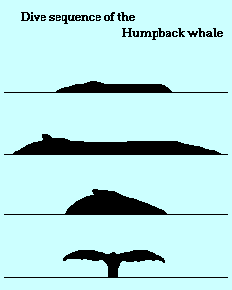The Humpback Whale
(Megaptera novaeangliae)
Length: 12-15 metres (40-60 feet) Lifespan 70-80 years.
Humpback whales in the Southern Hemisphere are proving to be different from those north of the equator (the northern species is known as M. n. angliae). The Humpback Whale is unlike any other Rorqual. The body is robust and narrows rapidly in front of the huge tail flukes. The head is broad and rounded, but the median ridge is indistinct and has been replaced by a string of fleshy knobs. Two further lines are arranged along the jaws.

The fin is small and varies in shape from triangular to shark-like. It is set two-thirds of the way back and mounted on a fleshy platform unlike that of any other Baleen whale. The most characteristic feature of the humpback is its enormous flippers. They are almost a third of total body length, about 5 metres (16 feet) long and heavily scalloped.
The whale's colour is generally blackish with a white area covering the throat grooves. It has broad flukes with highly scalloped edges, moderately notched. The underside of the flukes are marked with a variable pattern of white, making each whale recognisable at the surface as it throws its tail into the air. The flippers are mottled black and white with white underneath.
The blow is distinctive, seldom more than 3 metres high (10 feet) and is a single, straight column that spreads at the top, like the spout of a fountain. Breathing sequence usually involves 2 or 3 minutes at the surface, blowing once every 20-30 seconds, followed by a deep 'humpbacked' dive for 3-28 minutes. The fin is seldom seen until the high, rolling dive brings the hump into view before sounding. In warmer water, the number of breaths taken between dives is reduced from an average of 6 to 3.
Humpbacks often leap clear of the water, usually in an arching backflip, which brings the pale pleats of the throut into view. These whales can often be found lying motionless on the surface with one flipper hoisted like a sail. This raised flipper can slap the water hard, producing a noise like a gun shot. An even louder sound can be made by bringing the tail down sharply upon the water surface. This is called a lobtail.
| Bibliography | Whales on the Net |